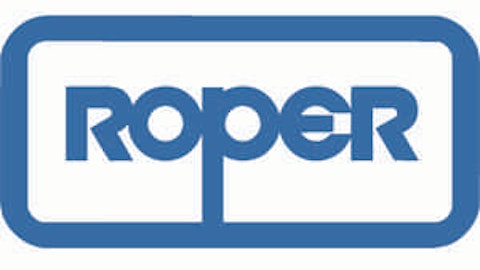Growth Prospects
Dover’s management allocates ~50% of capital to acquisitions and capital expenditures, and 50% to dividends and share repurchases.
 Source: Dover 12-15-15 Investor Presentation, slide 16
Source: Dover 12-15-15 Investor Presentation, slide 16
The company has spent more capital on acquisitions than on any other activity in recent years. Dover’s management is aggressively divesting small business lines and acquiring other (smaller) manufacturers that complement existing business units.
The company’s acquisition based strategy has worked well for Dover over the past decade, with earnings-per-share growing at around 7.5% in this time frame.
The company is expecting adjusted earnings-per-share of $3.85 to $4.05 ($3.95 at the median) in fiscal 2016, and earnings-per-share of $3.62 in full fiscal 2015.
Dover Corp (NYSE:DOV) is targeting 3% to 5% revenue growth over the long run. The company has a solid balance sheet; it has the capacity to continue adding smaller businesses to its operations. The company is also targeting continued margin expansion from better efficiency going forward.
I expect a compound annual growth rate of 8% to 12% for shareholders of Dover from the following sources:
– Dividend yield of 3%
– Revenue growth of 3% to 5%
– Share repurchases of 1% to 2%
– Margin improvements of 1% to 2%
The company’s growth will likely be slower as long as emerging markets continue to sputter and oil and gas prices remain low. This slowdown has negatively impacted earnings-per-share in 2015.
Recession Performance
Dover remained profitable throughout the Great Recession of 2007 to 2009. The company did see earnings-per-share declines at the height of the Great Depression in 2009, but future earnings power was not impaired as Dover managed to hit new earnings-per-share highs two years later in 2011.
The company’s earnings-per-share throughout the Great Recession and into recovery are shown below to give an idea of the impact of recessions on the company:
– 2007 Earnings-per-share of $3.22
– 2008 Earnings-per-share of $3.67
– 2009 Earnings-per-share of $2.00 (recession low)
– 2010 Earnings-per-share of $3.48
– 2011 Earnings-per-share of $4.49 (new earnings-per-share high)
Dover’s operations are affected by recessions as it sells components to businesses affected by recessions. The oil and gas industry will hold off on capital expenditures during recessions when money is (relatively) tight. In addition, many of the company’s other industrial suppliers experience cash flow reductions during recessions and hold off new purchases as well. This explains the company’s earnings-per-share drop in 2009. While Dover is not immune to recessions it has proven it can last through protracted economic downturns and remain profitable.
Valuation & Final Thoughts
Dover Corp (NYSE:DOV) has historically traded at a premium of about 1.1x to the S&P500’s PE ratio. The S&P500 is currently trading at a price-to-earnings multiple of 20.3.
At the market’s current level, this implies a fair price-to-earnings multiple for Dover of around 22. The company is currently trading at a price-to-earnings multiple of just 15.3 expected 2015 earnings.
I believe the company to be undervalued at current market prices. The company’s recent stock price reflects the general pessimism causing the company’s low price-to-earnings ratio. Over the last year, Dover’s stock has declined 17% due in large part to oil price declines.
Dover Corporation is a high quality business trading that is likely undervalued at current prices. The company has an above-average dividend yield of 3% as well.
Having the second longest streak of consecutive dividend increases on the market and a conservative payout ratio means it is extremely likely that Dover continues rewarding shareholders with rising dividend payments.
Dover ranks in the top 50% of dividend stocks using The 8 Rules of Dividend Investing due to the aforementioned financial metrics.
While the company is a bargain today, believe there are better investment options available in the manufacturing sector for dividend growth investors at this time.
Disclosure: None





